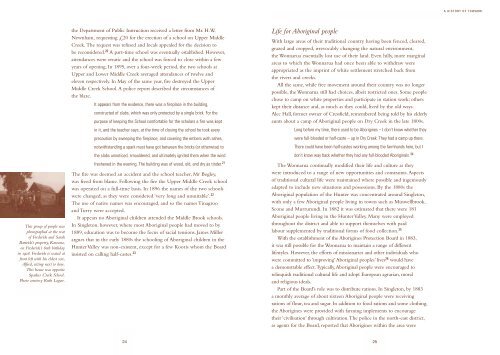Remembering Country: History & Memories of Towarri National Park ...
Remembering Country: History & Memories of Towarri National Park ...
Remembering Country: History & Memories of Towarri National Park ...
You also want an ePaper? Increase the reach of your titles
YUMPU automatically turns print PDFs into web optimized ePapers that Google loves.
This group <strong>of</strong> people was<br />
photographed at the rear<br />
<strong>of</strong> Frederick and Sarah<br />
Barwick’s property, Karoona,<br />
on Frederick’s 80th birthday<br />
in 1928. Frederick is seated at<br />
front left with his eldest son,<br />
Alfred, sitting next to him.<br />
This house was opposite<br />
Sparkes Creek School.<br />
Photo courtesy Ruth Logan.<br />
the Department <strong>of</strong> Public Instruction received a letter from Mr. H.W.<br />
Newnham, requesting £20 for the erection <strong>of</strong> a school on Upper Middle<br />
Creek. The request was refused and locals appealed for the decision to<br />
be reconsidered. 20 A part-time school was eventually established. However,<br />
attendances were erratic and the school was forced to close within a few<br />
years <strong>of</strong> opening. In 1895, over a four-week period, the two schools at<br />
Upper and Lower Middle Creek averaged attendances <strong>of</strong> twelve and<br />
eleven respectively. In May <strong>of</strong> the same year, fire destroyed the Upper<br />
Middle Creek School.A police report described the circumstances <strong>of</strong><br />
the blaze.<br />
It appears from the evidence, there was a fireplace in the building,<br />
constructed <strong>of</strong> slabs, which was only protected by a single brick. For the<br />
purpose <strong>of</strong> keeping the School comfortable for the scholars a fire was kept<br />
in it, and the teacher says, at the time <strong>of</strong> closing the school he took every<br />
precaution by sweeping the fireplace, and covering the embers with ashes,<br />
notwithstanding a spark must have got between the bricks (or otherwise) to<br />
the slabs unnoticed, smouldered, and ultimately ignited them when the wind<br />
freshened in the evening. The building was <strong>of</strong> wood, old, and dry as tinder. 21<br />
The fire was deemed an accident and the school teacher, Mr Begley,<br />
was freed from blame. Following the fire the Upper Middle Creek school<br />
was operated on a full-time basis. In 1896 the names <strong>of</strong> the two schools<br />
were changed, as they were considered ‘very long and unsuitable’. 22<br />
The use <strong>of</strong> native names was encouraged, and so the names Tinagroo<br />
and Turry were accepted.<br />
It appears no Aboriginal children attended the Middle Brook schools.<br />
In Singleton, however, where most Aboriginal people had moved to by<br />
1889, education was to become the focus <strong>of</strong> racial tensions. James Miller<br />
argues that in the early 1880s the schooling <strong>of</strong> Aboriginal children in the<br />
Hunter Valley was non-existent, except for a few Kooris whom the Board<br />
insisted on calling half-castes. 23<br />
24<br />
Life for Aboriginal people<br />
With large areas <strong>of</strong> their traditional country having been fenced, cleared,<br />
grazed and cropped, irrevocably changing the natural environment,<br />
the Wonnarua essentially lost use <strong>of</strong> their land. Even hilly, more marginal<br />
areas to which the Wonnarua had once been able to withdraw were<br />
appropriated as the imprint <strong>of</strong> white settlement stretched back from<br />
the rivers and creeks.<br />
All the same, while free movement around their country was no longer<br />
possible, the Wonnarua still had choices, albeit restricted ones. Some people<br />
chose to camp on white properties and participate in station work; others<br />
kept their distance and, as much as they could, lived by the old ways.<br />
Alec Hall, former owner <strong>of</strong> Cressfield, remembered being told by his elderly<br />
aunts about a camp <strong>of</strong> Aboriginal people on Dry Creek in the late 1800s.<br />
Long before my time, there used to be Aborigines – I don’t know whether they<br />
were full-blooded or half-caste – up in Dry Creek. They had a camp up there.<br />
There could have been half-castes working among the farmhands here, but I<br />
don’t know way back whether they had any full-blooded Aboriginals. 24<br />
The Wonnarua continually modified their life and culture as they<br />
were introduced to a range <strong>of</strong> new opportunities and constraints. Aspects<br />
<strong>of</strong> traditional cultural life were maintained where possible and ingeniously<br />
adapted to include new situations and possessions. By the 1880s the<br />
Aboriginal population <strong>of</strong> the Hunter was concentrated around Singleton,<br />
with only a few Aboriginal people living in towns such as Muswellbrook,<br />
Scone and Murrurundi. In 1882 it was estimated that there were 181<br />
Aboriginal people living in the Hunter Valley. Many were employed<br />
throughout the district and able to support themselves with paid<br />
labour supplemented by traditional forms <strong>of</strong> food collection. 25<br />
With the establishment <strong>of</strong> the Aborigines Protection Board in 1883,<br />
it was still possible for the Wonnarua to maintain a range <strong>of</strong> different<br />
lifestyles. However, the efforts <strong>of</strong> missionaries and other individuals who<br />
were committed to ‘improving’Aboriginal peoples’ lives 26 would have<br />
a demonstrable effect.Typically,Aboriginal people were encouraged to<br />
relinquish traditional cultural life and adopt European agrarian, moral<br />
and religious ideals.<br />
Part <strong>of</strong> the Board’s role was to distribute rations. In Singleton, by 1883<br />
a monthly average <strong>of</strong> about sixteen Aboriginal people were receiving<br />
rations <strong>of</strong> flour, tea and sugar. In addition to food rations and some clothing,<br />
the Aborigines were provided with farming implements to encourage<br />
their ‘civilisation’ through cultivation.The police in the north-east district,<br />
as agents for the Board, reported that Aborigines within the area were<br />
25<br />
A HISTORY OF TOWARRI

















